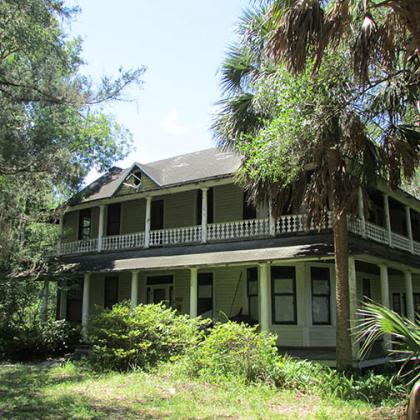There’s no doubt you’ve noticed the old house if you’ve traveled down St. Johns Avenue during this century – or the last. It is roughly 75 yards or so off the main artery running through downtown Palatka.
The old white house at 2200 St. Johns Ave. stands behind a stoned arch entrance. It sits on just over 3 acres, one of the largest residential parcels of land within the city of Palatka.
And the old house is for sale.
“If someone was able to bring it back to its original glory, it would be one of the showcases of the city,” said Robbi Correa of Duck Realty. “This house draws a lot of attention. To see it restored would bring a sense of pride to the community.”
Built around 1875, the house is often referred to as the Moseley-Wood House. Contrary to what some believe, William Moseley did not live in the house. Moseley, the first elected governor of Florida, came to live in Palatka in 1851, according to a book published in 1992 by the Putnam County Historical Society.
According to Larry Beaton, the historian for the society, many people believe Moseley lived in the house because the property was part of a much larger tract of land he owned. That tract – hundreds of acres stretching nearly to what is now Ravine Gardens State Park – was the site of a large orange grove owned by Moseley.
Moseley died in 1863 and is buried in Westview Cemetery in Palatka. He died 12 years before the land where the house is located was sold to Dr. Andrew J. Wood. Beaton said the transfer of the land – about 100 acres at the time – to Wood would have been done by an heir of Gov. Moseley.
Wood, who would later become superintendent of public instruction for Putnam County, reportedly paid $800 for the property and built the house on the site. The property was later sold to Dr. James W. McGregor in 1889, according to the historical society book.
It was sold again in 1919 to Mrs. D. Lura Dowda Calhoun, who would later sell it to her daughter, Eudora Dowda McTurk. She lived there for many years. Ownership of the house has changed over the years and time has caused the house to lose some of its original majesty.
But it’s not too difficult to envision the estate as it was in the 19th century in the heart of old Florida when Palatka was a thriving city as a gem along the St. Johns River.
“I think one of the first things I notice is the fact that it was such a beautiful house and there’s no surrounding property around it,” Beaton said. “With the Wood house, you get the feeling of what it may have looked like at its peak. And a lot of the grounds are still intact.
“Even in the condition it’s in now, it’s still beautiful, and to think about what it was once like. Just going by and looking at it, you can definitely tell it was a showplace in Palatka.”
Since moving to Palatka 15 months ago, I’ve noticed the house many times and wondered about its history. When I discovered it was for sale, I asked Correa if she would give me a tour of the property as a subject for this column. She said there has been a lot of interest in the house since it was listed a few weeks ago.
In addition to its history, the price of the house is another reason it has garnered attention. The Eastlake-style Victorian is listed at $155,000. Consisting of about 5,000 square feet – roughly $31 per square foot – the double-tiered verandah features a wraparound view, five bedrooms, three full baths and much more. There’s also a turret – a tower – that is a prominent feature to the front of the house.
Oh, it needs some work. Lots of it. Some tender loving care. So, too, does the landscape that engulfs it.
Inside the home, you notice some unwelcomed guests have visited, leaving behind damage and other personal belongings.
But look past that hard enough and you’ll see the potential the house has for someone with the time, money and patience to restore it.
The bones are there, inside and outside. There are several fireplaces with striking mantles. There are the original hardwood floors. There is the architecture. And, of course, there is the history. Part of the property is said to have been used as a hospital during the Civil War, although Beaton said that’s something he hasn’t been able to confirm.
You can imagine the possibilities today for the house – a bed and breakfast, a wedding venue or its return to a private residence.
“To me, the house and the property has the feel of something grand,” Correa said. “It represents a lost era and in that way it reminds me somewhat of the Bronson-Mulholland House. It could be pretty spectacular.”
Beaton agrees.
“It is a beautiful home and it would be wonderful to see it restored,” Beaton said. “It would be another location where we would be proud to showcase the rich history of the community.”
No doubt.
Wayne Smith is the editor of the Palatka Daily News. His email is wsmith@palatkadailynews.com.

